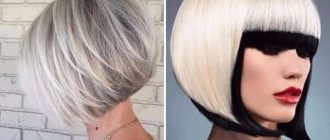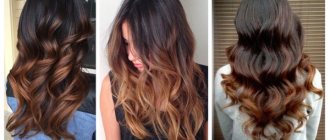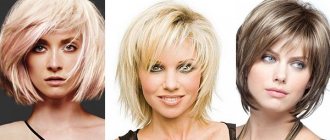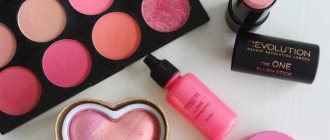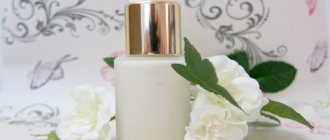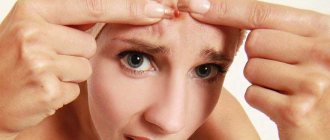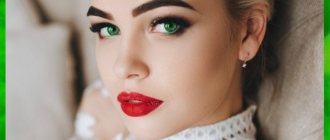Lately, everyone has been talking about the miraculous properties of retinol (or its other name, vitamin A): scientists, cosmetologists, beauty bloggers. However, do not rush to follow advice from the Internet and immediately buy a cream with this ingredient. The effects of retinol can be both positive and negative. And this depends not only on the individual characteristics of the skin and body, but also on age, personal care rules, even the combination of retinol with other vitamins and components. Detailed instructions about retinol from the best cosmetologists and doctors in Moscow are in our article!
What is retinol and why is it so popular?
Victoria Goncharuk
dermatologist-cosmetologist
– Retinol is the first vitamin discovered by scientists in 1913, which is why it received the name of the first letter of the alphabet. This is a fat-soluble vitamin that easily penetrates the epidermis. Retinol is essential for healthy skin and hair, normal functioning of the immune system, as well as for the growth of new cells and slowing down the aging process.
Signs of vitamin A deficiency include the appearance of peeling skin, increased dryness, conjunctivitis, dandruff, hair loss, decreased visual acuity (especially at night), and increased susceptibility to infections. Large amounts of retinol are found in fish, liver, vegetables and orange and yellow fruits (carrots, pumpkin, apricot). But for retinol to be absorbed in the digestive tract, fats are required.
Why is retinol so effective for the skin?
The effectiveness of this asset is explained by the interaction of its biologically active form with skin cells through retinoic receptors.
Simplified, the mechanism of action and transformation can be represented by the following sequence.
Retinoids applied to the skin are converted into retinal - then into retinoic acid - which interacts with skin cells through retinoic receptors and corrects a specific problem.
If we keep in mind that retinol acetate and palmitate are used in cosmetics for facial skin, then the sequence of transformations will be as follows.
Retinyl acetate or retinyl palmitate in cosmetics applied to the skin is converted into retinol - then into retinal - then into retinoic acid - which interacts with skin cells through retinoic receptors.
| This is interesting. We have placed the unique property of retinol for facial skin - interaction at the cellular level - in one paragraph. In scientific research, it took a century, without a quarter. In 1909, a fat-soluble factor necessary for the development of the embryo was isolated; it was later named vitamin A. In 1987, cell receptors that are affected by retinoic acid were described. |
You should not think that the best cosmetic product contains the most biologically active form of retinoid.
The fact is that cells are very sensitive to the concentration of retinoic acid and any change in concentration leads to a strong change in their vital activity. It should also be taken into account that the skin cannot take as much retinoic acid as it needs from a superficially applied product. She will take whatever is available, and this can cause severe irritation and a violent response.
Therefore, retinoic acid is used much less frequently than other retinoids, and if used, it is in low concentrations, for a limited period of time, and in medications.
At the current level of development of biotechnology, rather, the problem of using retinol and retinoic acid for facial skin is not increasing efficiency, but reducing irritation during use and the stability of this asset in cosmetic formulas.
What effect does retinol have on the skin?
Daria Yakushevich
dermatovenerologist, cosmetologist, surgeon, head of the department of facial and body aesthetics X-Clinic
– Retinol is very unstable to the external environment and breaks down easily, so it is used in the form of various compounds - retinol palmitate, retinol acetate and others. You must also remember that it is not retinol itself that works in the skin, but its derivative, retinoic acid. This compound has receptors in skin cells and activates their division and synthetic activity.
Preparations with retinol are especially useful for patients with acne and tan lovers with signs of photoaging. In these cases, all the beneficial properties of this compound are manifested: acceleration of skin renewal, pronounced antioxidant protection, regulation of the sebaceous glands. As a result of using retinol, complexion improves and age spots lighten.
For patients with acne there is no age requirement; all appointments must be according to indications. To prevent chrono- and photoaging, retinol can be used as early as 25–30 years of age. However, when using products with this component, you must follow a number of rules. Otherwise, you can only harm your skin.
The use of retinol and its miracle properties for the face.
Surprisingly, vitamin A has two groups of properties unrelated to each other. These are properties that reduce signs of age-related changes and properties that suppress inflammation in oily skin and correct acne. This is explained by the fact that retinoids affect various skin cells. You can read about the structure of the skin and epidermal cells in the article - Epidermis.
The anti-aging effect is due to its effect on keratinocytes and fibroblasts.
In the case of sebum regulation and care for oily skin, the cellular target for retinoids are sebocytes.
Cosmetic properties of retinol for facial skin.
Use in the care of oily, problem skin.
- Eliminates acne.
- Corrects oily skin problems, acne, normalizes sebum secretion, eliminates post-acne.
Use for anti-aging facial care.
- Prevention of aging. Reduces the effects of various types of aging: photoaging, chronoaging and hormonal aging.
- Helps reduce the stratum corneum, normalizes excessive keratinization of epidermal cells (hypercaratosis).
- Promotes thickening of the epidermis, namely the epidermis, and not its stratum corneum.
- Accelerates the process of cell renewal.
- Like peelings, it accelerates the renewal of the epidermis.
- Exfoliation (used in peelings). Superficial peelings are the most effective and affordable way to rejuvenate facial skin for home care. It is based on a natural renewal process. Read more - What is facial peeling.
- Reduces wrinkles, improves skin firmness and elasticity, restores collagen matrix.
- Reduces pigmentation. Pigmentation on the face can have several causes. How lightening cosmetics work, what assets and methods for eliminating pigmentation are available in home cosmetics lines - How to whiten pigment spots on the face.
In some cases, retinol is irreplaceable for facial skin; it is a truly multifunctional component. In addition to acting at the clinical and histological levels, it actively manifests itself at the cellular, immunological, biochemical and molecular levels.
Retinoid activity in different layers of the skin.
Forms of vitamin A are fat-soluble, have a small lipophilic molecule, and penetrate the stratum corneum barrier relatively easily.
Having penetrated the epidermis, retinoids affect the processes of keratinization and pigmentation.
The created concentration gradient promotes the penetration of retinol into the dermis, where it participates in the processes of restoration of the intercellular matrix, which degrades with aging or due to ultraviolet irradiation (hello to the sun, the main factor of photoaging).
The use of retinol in cosmetics corrects the signs of various types of facial aging - chrono- and photoaging. You can read more about these signs and the reasons for their appearance in the article – Types and types of aging.
How to use retinol creams
Retinol is a complex compound, and before you start using it, you should do an allergy test on an inconspicuous area of skin (usually it is done on the inner surface of the forearm). If the allergy test gives a negative result, then you can introduce this component into your care. But gradually, starting with small quantities and infrequent use.
It is also important to remember that at the beginning of therapy, phenomena such as dry skin and itching are possible, so immediately stock up on good moisturizing serums and creams. In addition, we must not forget that retinol derivatives increase skin sensitivity to solar radiation, which is the reason for the constant use of products with SPF protection. Experience suggests that the vast majority of patients no longer leave home without sunscreen, even in winter, but when using retinoids, control should be strengthened.
Speaking about the interaction of various products, one of the main rules is not to mix retinol with vitamin C in one application. In order to get the effect of each of these components, it is better to use retinol in the evening, and vitamin C in the morning.
Also, when treating acne, you should not combine retinol with benzoyl peroxide (Baziron) to avoid severe irritation and possible burns!
The downside is retinol and facial skin irritation, how to use it correctly.
The more effective the product, the greater the likelihood of side effects. This fully applies to retinoids. It is the side effects of retinoids that limit their use. First of all, this concerns the most active form – retinoic acid.
The horror story about retinoic acid should not be a reason to avoid retinol for facial skin care. This active is not used in home professional cosmetics lines, and other retinoids do not have such an irritating effect. If they are used correctly, you will know about the side effects, but not from your personal experience.
The aggressive effect of retinoic acid is rather an exception. Cosmetics with acids, a reliable and proven assistant. For example, PHA acids have been synthesized, which are used to care for dry and sensitive skin. For more details, read – Cosmetics with acids.
| This is interesting. When taken in excess, vitamin A becomes toxic. There are known cases of Arctic travelers being poisoned by polar bear liver, which weighs 250 grams in a piece. contains a concentration of vitamin A 1000 times higher than the daily requirement. |
Symptoms of vitamin A food poisoning.
- The skin is peeling.
- Vision deteriorates.
- Hair fall out.
- A change in mental state is possible; this most often happened to the brave explorers of the sulfur pole.
If we talk about an overdose when using retinol for facial skin, then the side effects include:
- Irritation in the form of: redness, peeling, swelling.
- Increased skin photosensitivity.
A possible side effect is not a reason to exclude cosmetics with retinol for facial skin care. Moreover, the most active form, retinoic acid, is found in medicines, and not in cosmetics. Following simple rules will painlessly adapt the skin to retinoids, and make care effective and safe.
Contraindications
Daria Yakushevich
dermatovenerologist, cosmetologist, surgeon, head of the department of facial and body aesthetics X-Clinic
– As mentioned earlier, when using retinol, peeling, itching and tightness may occur. If these phenomena cannot be controlled, it is necessary to stop using the drug.
In addition, vitamin A is completely contraindicated during pregnancy and breastfeeding, and if the patient is going to undergo the retinoic (so-called yellow) peel procedure, he is advised not to plan a pregnancy for several months after the procedure.
Combination of retinol and other cosmetic actives in facial skin care.
Vitamin A is a strong cosmetic agent.
This is a fact from which it follows that the combined use of retinoids with other actives that have similar effects is limited. First of all, this applies to the following influences and corresponding assets with similar effects:
- Thinning of the stratum corneum. Colleagues with similar effects are acids. Both acids and retinol thin the skin of the face.
- Collagen synthesis – fellow phytoestrogens.
- Immunomodulatory effect – beta glucan.
But here is the company in which retinoids feel good - vitamins E, C, D.
On the other hand, everything is poison and everything is medicine, the dose does both. This fully applies to the compatibility of assets, their dosage and cosmetics manufacturing technology. Using retinol for facial skin care is not a simple task with many variables, which professional cosmetics brands can solve. That is why it is better to use professional cosmetics in home care. More details – Facial care cosmetics, beauty salon at your home.
How to choose a product with retinol
“The concentration of retinol in the cream should be no less than 0.1% (preventative agents) and no less than 0.4% (therapeutic agents), says dermatologist-cosmetologist Victoria Goncharuk . – If the manufacturer does not indicate the percentage of retinol on the package, then the lower the mention of vitamin A in the list of ingredients, the lower its concentration. It’s better to look for products that list retinol at the top of the ingredient list.”
At the same time, Maya Zhmareva from Verba Mayr advises choosing products with a retinol concentration of 0.2%.
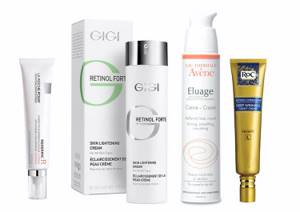
Cream for all skin types Redermic R, 1959 RUR, La Roche-Posay. Whitening cream Skin Lightening Cream Retinol Forte, RUB 4,275, GIGI. Restoring wrinkle cream Eluage Cream Anti-Ageing Restructuring, RUB 2,195, Avene. Night cream Retinol Correxion, Deep Wrinkle Night Cream, about 1047 RUR, RoC
What retinol is in cosmetics: esters, encapsulation.
Vitamin A is an unstable substance; light and oxygen have a detrimental effect on it. This limits its use in cosmetics in its pure form. Therefore, modifications of vitamin A are used in skin care products. The most widespread are:
- esters: palmitate and retinol acetate,
- as well as encapsulated form.
These forms are more resistant to light and oxygen compared to their parent.
Esters have inherited all the wonderful cosmetic properties of retinol for facial skin, except for their ability to penetrate the stratum corneum. The penetration ability of esters is worse than the penetration ability of retinol. The encapsulated form has relatively good penetrating ability.
These components are included in most cosmetic products - serums and creams; they are used for anti-aging cosmetics, correction of age spots, as well as eliminating problems of oily skin and acne.
Together with retinoids, vitamins E and C are introduced into cosmetic compositions, which stabilize the cosmetic composition, give the esters greater stability, and also provide a synergistic antioxidant effect. The fight against free radicals is one of the distinctive features of vitamins; read more - Antioxidants in cosmetics.
The concentration of retinoids in cosmetics depends on the form used.
The practice of using retinol and its esters in facial cosmetics has determined the following concentrations.
- Concentration in facial skin products is up to 0.2%, depending on the type of product. The maximum concentration for night cream and after sun cream is 0.2%.
- Peeling concentrations are approximately 1%.
- Retinyl palmitate – up to 0.5%.
- Retinyl acetate – up to 5%. The maximum concentration is in night cream and after sun cream.
As can be seen from the given concentrations, the most effective component for the skin is retinol, less effective, and therefore safer in relation to possible adverse reactions, is retinyl acetate.
However, these concentrations do not take into account the form of retinol delivery to the skin and the time of its release. Using an encapsulated form, you can increase the applied concentrations to 1%, which means increasing the effectiveness of cosmetics.
The concentration of retinol depends on the method of its penetration, and if an encapsulation system is used, then on the release time.
Renewing night cream 1% retinol, for home care ZO Skin Health (Obagi).
Suitable for all skin types, for skin with signs of age-related changes. Special anti-aging care is provided by a unique composition of vitamins A, C and E, as well as the patented ZO-RRS2 complex.
Result of application. Smooth skin, reduced wrinkles, even tone.
Anti-age, Brightening, Whitening effect.
Retinol release form
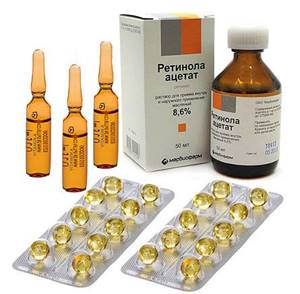
Before using retinol acetate, you need to find out in what form it is available:
- Oil solution for internal use. The concentration of the main component is different - 3.44% and 8.6%. It is drunk and also used for external use;
- Soft gelatin capsules filled with an oily yellow liquid. They are taken orally or punctured and the solution is added to ready-made creams or added to home remedies;
- Solution for injections. Its direct purpose is intramuscular injections, but the liquid is often used to prepare masks.
It is important to remember that the solution cannot be used in its pure form, as the likelihood of adverse reactions increases. To soften the aggressive effect of the concentrated vitamin, you need to combine it with other ingredients.
Retinol reduces wrinkles and treats acne. What else can he do?
Do you always need sunscreen if you use a cream with retinol? Is it possible to use products with retinol during pregnancy? Is it true that if you sit on them for a long time, a “plateau” comes and then everything is useless? We answer the most popular questions about retinol.
Our experts:
Marina Agapova
Marina Agapova (@dr.marinaagapova) is a dermatologist-cosmetologist, chief physician of Versua Clinic, trainer of the Sesderma brand, certified trainer of Aptos thread methods.
Oksana Ivanova
Cosmetic chemist, creator of the G.Love brand, co-owner of contract manufacturing of cosmetics at Doka Lab.
Natalia Raevskaya
Chief physician of preventive medicine in the Gen87 network of clinics, cosmetologist, dermatovenerologist.
What is retinol?
Retinol is a form of vitamin A.
How long ago did they start using it in cosmetology?
Vitamin A (“A” because it was the first vitamin discovered) was first discovered in 1913 in butter and chicken egg yolk. In the body, vitamin A is produced from beta-carotene and is responsible for immunity, night vision, epithelial integrity, and growth. It was synthesized for the first time in 1947. True, at first not for adding to the cream, but for use internally, in the form of capsules.
Retinol has been used in cosmetics since the 1960s. At first - exclusively as a means to treat acne.
“Retinoids were used in medications to correct severe forms of acne. They began to be actively used for cosmetic purposes only in the last 5 years.”
Oksana Ivanova
What is he doing?
Honestly - a lot of things. For example:
- Fights wrinkles. Retinol is the first and only ingredient approved by the FDA as an anti-wrinkle product. It stimulates the production of new cells and increases the rate at which these cells move to the surface of the skin. The study found that after 12 weeks of use, wrinkles were significantly reduced.
- Stimulates the production of collagen and hyaluronic acid . Here are the results of a study conducted by Shisiedo in 2021. The first square is the dermis at the beginning of the study, the fourth - after 12 weeks. The green dots are collagen and hyaluronic acid.
- Thickens the dermis. It has been observed that the use of retinol increases the number of epidermal keranocytes, fibroblasts and endothelial cells, thereby thickening the dermis.
- Lightens post-inflammatory and solar pigmentation.
- Works as an antioxidant.
- Fights acne. Retinol makes sebum more liquid and has an anti-inflammatory effect. When used for 3-4 months, 75% of patients suffering from acne are satisfied with the results.
- Synthesizes lipids , which create a protective layer, prevent moisture evaporation and create a favorable environment for the microbiome.
Okay, but what does it NOT do?
- Retinol does NOT work as an exfoliant. Peeling often occurs when using products containing retinol, and some people think that this is a result of effective exfoliation. No. Peeling is a sign that you have gone too far with the concentration or have chosen the accompanying care incorrectly.
Are retinol and retinoids the same thing?
Not really. Retinol is a form of retinoids (vitamin A). There are more than 2,500 retinoids, but several forms are used in skin products: retinoic acid (retinoic acid, Retin-A or tretinoin), retinaldehyde (retinal), retinol (retinol), retinyl palmitate (retinyl palmitate), retinol acetate (retinol acetate), where retinoic acid (Retin-A) is the most potent form and retinol acetate is the mildest.
“Most often, encapsulated forms of retinoids are used in cosmetics. The capsules help keep the ingredient stable.”
Oksana Ivanova
Retinolic acid begins to work immediately after application. Other forms of retinoids are converted into retinoic acid only when they come into contact with the skin - under the influence of enzymes and oxygen. Then this same acid provokes cell division, leading to thickening of the stratum corneum.
The conversion scheme is as follows:
Retinyl palmitate → Retinol → Retinaldehyde → Retinoic acid (Tretinoin)
Why then doesn't everyone just use tretinoin if it is the most effective?
The release of retinoic acid from all other forms of retinoids occurs gradually. This minimizes the likelihood of side effects.
“The use of tretinoin can cause destruction of the stratum corneum of the skin, thinning of the epidermis, and increased sensitivity. Therefore, this ingredient should only be used under medical supervision.”
Oksana Ivanova
All the forms we discussed above (except retinoic acid) can be used in over-the-counter cosmetics. And retinoic acid is exclusively a medicine prescribed by a doctor. This is true not only for Russia, but also for the USA and Europe.
“Tretinoin is only prescribed to adults as part of therapy for the treatment of severe acne.”
Marina Agapova
Since retinol is so effective, should everyone use it?
No. Retinol is contraindicated in pregnant and lactating women as it is believed that it may be toxic to the fetus and child. True, over 25 years, not a single case has been identified in which the local use of retinol would have harmed the fetus. There is little research on this topic, as it is considered unethical - pregnant women are not the right people to conduct experiments on. (This is also true for other ingredients and drugs: there are no studies on pregnant women, so almost everything is prohibited, just in case.) But doctors are of the opinion that it is better not to.
And, of course, young skin without acne does not need retinol either.
What are the side effects of using retinol?
Peeling, which we wrote about above. As well as irritation and burning. As a rule, they occur if a high concentration of retinol is applied to unprepared skin.
If side effects occur, you should temporarily discontinue retinol and wait until the skin recovers.
However, systemic (that is, affecting the entire body) side effects have not been observed with long-term retinol treatment over the past 30 years.
How to minimize the risk of side effects?
To reduce the likelihood of side effects, introduce retinol products gradually, gradually increasing the concentration and frequency of use. To avoid unreasonably fast and deep penetration of retinol into the skin, apply products to a dry face 30 minutes after washing.
“It’s better to start with a concentration of 0.15-0.3, using the product once every two weeks. After a while, you can switch to daily use. Then, increase your concentration.”
Marina Agapova
When cleansing your skin, use a mild product. If your serum contains retinol, follow it up with a rich moisturizer. It’s good if the cream contains lipids. If you are not using a serum, but a cream with retinol, additional moisturizing is not required, since it probably already contains the necessary components.
What concentration of retinol is considered working?
Home remedies use a concentration of 0.1% - 1%. A concentration of more than 1% is considered a professional “yellow peeling”; home remedies with such retinol content are not produced.
There are studies (,), based on which it can be assumed that when the concentration of retinol is increased from 0.15% to 0.5%, the effect remains virtually unchanged, but side effects become more likely.
I heard that retinol cannot be combined with AHA acids, is that true?
There is an opinion that retinol and acids deactivate each other, but this is not true. They work in different layers of the skin. Acids are on the surface, retinol is in the deeper layers of the epidermis.
“For sensitive skin, it is still better to dilute these ingredients over time to minimize the risk of irritation. For example: acids - in the morning, retinol - in the evening."
Marina Agapova
When will I see the result?
Long-lasting anti-aging effects, such as reduction of wrinkles, become noticeable after 12 weeks.
With acne it is more difficult: the time it takes to achieve results depends on the causes and severity of the acne.
Can retinol be used all year round?
Cosmeceutical retinol with a concentration of 0.25-0.5 is possible - with caution, Sanskrin is required! - use at any time of the year at night. If its concentration in the product is higher, then we use this product only in the autumn-winter period.
By the way, is it always necessary to use Sunscreen when using retinol?
Yes. Tiina Orasmäe-Meder: “Sansscreen is definitely needed, starting from the first day, as soon as you start using products with retinol. Retinol quickly increases skin sensitivity to ultraviolet radiation.”
Is it possible to use retinol constantly and does it make sense? They say that after some time there is a plateau and it no longer works.
There are different opinions on this matter. According to some sources, retinol in concentrations up to 1% can be used continuously. Research shows that when you use retinol for a year, consistent changes occur over time. When using a retinol cream for 52 weeks at a concentration of 0.1%, wrinkles are reduced by 44% and pigmentation by 83%.
Other cosmetologists, for example, Tiina Orasmäe-Meder, do not agree with this. In her opinion, products with retinol should be used no longer than 16-21 weeks in a row: “Such long-term use is justified only in cases of solar elastosis under medical supervision. But when it comes to healthy skin without significant damage, but with physiological age-related changes, a course longer than 20 weeks carries more risks than benefits. From this time on, the positive effects fade away, and the side effects increase and become persistent.”
But there are plant analogues of retinol. They work?
Bakuchiol is an extract from the seeds and leaves of the Indian plant Psoralea. According to the study, the results of using 0.5% retinol for 12 weeks are comparable to using 0.5% bakuchiol when used as an anti-aging agent.
With the treatment of acne, everything is not so clear; there is little research on this topic. But there is evidence that bakuchiol inhibits the growth of the P.acnes bacterium and shows good results in the fight against inflammation.
“For oily skin, another salvation has now emerged - avocutin, a substance that is extracted from the pulp of avocados. Like bakuchiol, it is a completely natural ingredient. It inhibits the same enzyme as retinol. And just like retinol, it reduces fat content by 30% in two weeks of daily use without causing side effects. It does not cause peeling or irritation: it does not accelerate skin renewal, it simply disables the key enzyme that synthesizes sebum,” Tiina Orasmäe-Meder.
Retinol Products We Love
Retinol: instructions for use
The drug must be taken either early in the morning or late in the evening, and in both cases, after meals. The dosage depends on the patient’s age and disease:
- with mild and moderate vitamin deficiency, adults consume no more than 33,000 IU per day;
- with mild and moderate vitamin deficiency, children consume up to 5000 IU per day.
For the treatment of acne, the daily dosage is increased to 300 thousand IU (for adults). To treat gas diseases, adults take no more than 100 thousand IU, and at the same time use 20 mg of the drug “Riboflavin”.
